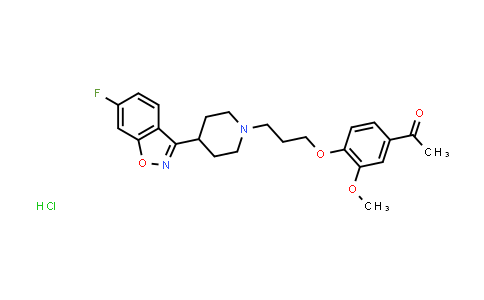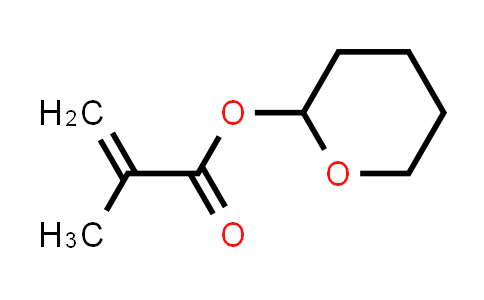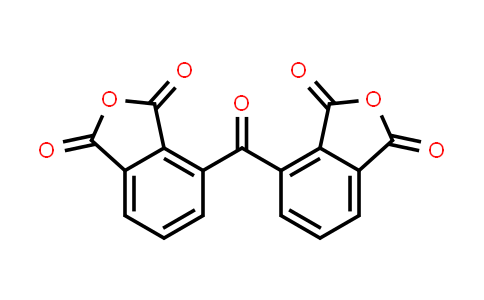
Iloperidone (hydrochloride) NLT 98%
製品番号 : MC516655
CAS番号 : 1299470-39-5
分子式 : C24H28ClFN2O4 | 分子量 : 462.94
和名別名 : HP 873 hydrochloride
大量製造見積依頼| 純度 | NLT 98% |
|---|---|
| 貯蔵 | at 20ºC 2 years |
| MolCoreは高純度の製造を専門としていますCAS No.1299470-39-5, Iloperidone (hydrochloride) 分子式 C24H28ClFN2O4、分子量 462.94 を持ち、ISO 品質システムで認証された、世界中の製薬業界および研究業界向けの重要な API 中間体を提供します。 | |
* 上記の情報はご参考にしていただければ幸いだと存じます。
| 和名 | Iloperidone (hydrochloride) |
|---|---|
| CAS番号 | 1299470-39-5 |
| 分子式 | C24H28ClFN2O4 |
| 分子量 | 462.94 |
| 和名別名 | HP 873 hydrochloride |
Iloperidone (hydrochloride) is a D(2)/5-HT(2) receptor antagonistis, which is an atypical antipsychotic for the treatment of schizophrenia symptoms. Target: 5-HT receptor; Dopamine receptor Iloperidone (hydrochloride) is the hydrochloride of iloperidone, iloperidone (HP 873; 1-[4-[3-[4-(6-fluoro-1,2-benzisoxazol-3-yl)-1-piperidinyl]propoxy] -3- methoxyphenyl]ethanone) is a compound currently in clinical trials for the treatment of schizophrenia. Iloperidone displays affinity for dopamine D2 receptors and for 5-HT2A receptors and has a variety of in vivo activities suggestive of an atypical antipsychotic. Iloperidone displayed higher affinity for the dopamine D3 receptor (Ki = 7.1 nM) than for the dopamine D4 receptor (Ki = 25 nM). Iloperidone displayed high affinity for the 5-HT6 and 5-HT7 receptors (Ki = 42.7 and 21.6 nM, respectively), and was found to have higher affinity for the 5-HT2A (Ki = 5.6 nM) than for the 5-HT2C receptor (Ki = 42.8 nM) [1]. Iloperidone was eliminated slowly, with a mean t1/2 of 13.5 to 14.0 hours. Coadministration with food did not significantly affect AUC, tmax, or Cmax. These results indicate that the rate of iloperidone's absorption is decreased, but the overall bioavailability is unchanged, when the drug is taken with food. Orthostatic hypotension, dizziness, and somnolence were the most commonly reported adverse events [2]. Iloperidone pharmacokinetics and pharmacodynamics are presented herein, together with an evaluation of clinical safety and efficacy results [3]. Clinical indications: Post traumatic stress disorder; Schizophrenia Toxicity: Commonly observed adverse reactions (incidence ≥5% and two-fold greater than placebo) were: dizziness, dry mouth, fatigue, nasal congestion, orthostatic hypotension, somnolence, tachycardia, and weight increased.
© Copyright 2015-2025 Hangzhou MolCore BioPharmatech Co.,Ltd. All rights reserved.



![MC569017 | 724445-24-3 | Methyl 3-hydroxy-4-oxo-6,7,8,9-tetrahydro-4H-pyrido[1,2-a]pyrimidine-2-carboxylate MC569017 | 724445-24-3 | Methyl 3-hydroxy-4-oxo-6,7,8,9-tetrahydro-4H-pyrido[1,2-a]pyrimidine-2-carboxylate](https://stcdn.molcore.com/molcore/structure/MC569017.png)
![MC537748 | 2009134-86-3 | 2H-1,4-Diazepin-2-one, 6-[(3-fluorophenyl)methoxy]-4-(2-furanylcarbonyl)hexahydro-1-[(3-methylphenyl)methyl]- MC537748 | 2009134-86-3 | 2H-1,4-Diazepin-2-one, 6-[(3-fluorophenyl)methoxy]-4-(2-furanylcarbonyl)hexahydro-1-[(3-methylphenyl)methyl]-](https://stcdn.molcore.com/molcore/structure/MC537748.png)